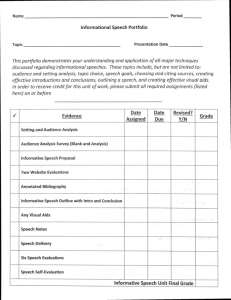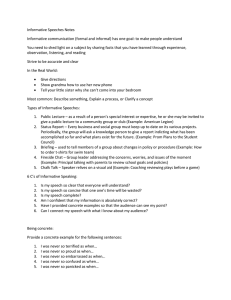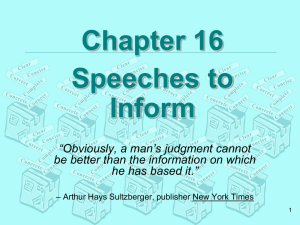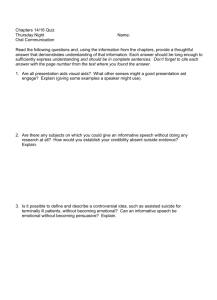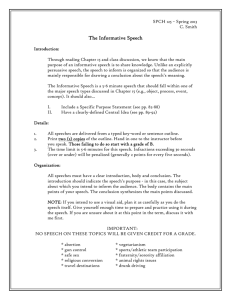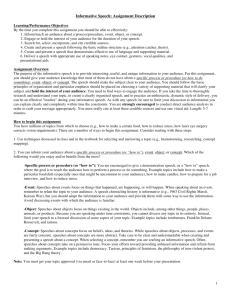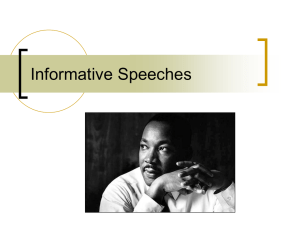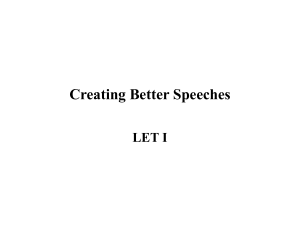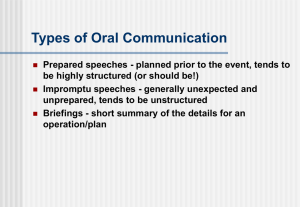Chapter 16
advertisement
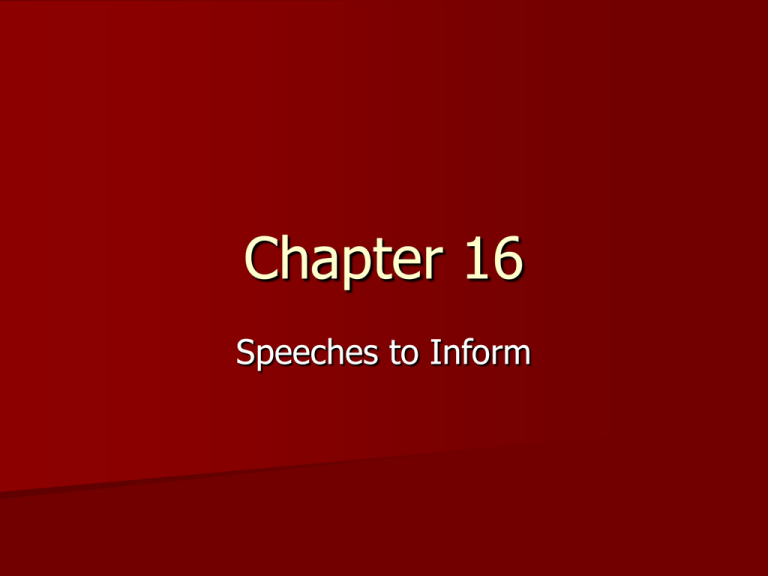
Chapter 16 Speeches to Inform Section 1: Speeches that Instruct, Inform, and Clarify Types of Informative Speeches public lecture – person is invited to lecture as result of special interest or expertise. status report – knowledgeable person gives report to group indicating what has been accomplished so far and what plans exist for the future. briefing – telling group about changes in policy or procedure. fireside chat – group leader addresses concerns, worries, and issues of the moment. (Franklin Roosevelt below) chalk talk – speaker relies on visual aid to show something to the group. – Many informative speeches are followed by Q & A session. The Six Cs of Informative Speaking – Be Clear – – Be Concise avoid redundancy don’t be too wordy choose the best word for the meaning you intend Tell the audience how many points you will make and then use words like “first”, “second”, “third”, so they will know when you are finished Advance organizers – statements that forecast what the audience can expect Have a plan (outline) and use transitions so your audience can follow Be Complete – Be Correct – check & double-check your facts identify your sources Be Concrete – define new words to audience make distinctions (what something is and what it is not) be specific rather than general talk about people, places, and things rather than general ideas give concrete examples of what you’re talking about Connect analyze your audience use a checklist – – – – how many people will be present? What will be the ages of most of the people in the audience? Will the audience be mostly male, female, or mixed? What are their interests, attitudes, and beliefs? What do they know about the subject? What is their attitude toward it? cultural literacy – the information that an average American citizen can be expected to know Turning a Subject into a Speech – – – Find a Subject Personal Experience Observations Surveys Narrow Your Subject Limit Limit Limit Limit your your your your subject subject subject subject State Your Thesis in time in space in extent using the principle of divide and conquer thesis – a positive statement about your topic Topics Thesis Teenagers and fads The slang teenagers use often comes from the latest popular movies. Healthy lifestyles Eating five servings of fruits and vegetables each day can dramatically reduce your chances of getting cancer. Famous musicians Beethoven’s hearing loss may actually have helped him compose music. – Support Your Thesis Facts Everyone loves a story Quotable quotes Defining your terms Descriptions Audio and Visual Aids – Two-Dimensional Visual Aids – Photographs, Drawings, and Cartoons Graphic Representations Chalkboard aids Handouts Projections – Overhead projector Slides Videotape Three-Dimensional Visual Aids – – Models Cutaways Sound Recordings Guidelines for Using Aids be sure the aid is large enough to be seen or loud enough to be heard be sure the aid contributes to the idea being presented. If you can get along without it, don’t use it. It takes time away from the rest of your presentation. don’t stand in front of the aid. talk to your listeners, not to the visual aid. keep any visual aid out of sight until you are ready to use it, and then put it away again when you have finished. don’t overdo a good thing. A long succession of slides or charts can become boring. remember Murphy’s Law – if something can go wrong, it will. Have a backup plan in case your equipment fails Practice, practice, practice. Pop Quiz 1. 2. 3. List the five types of informative speeches. List the six Cs of informative speaking. List four ways to narrow your speech subject.

